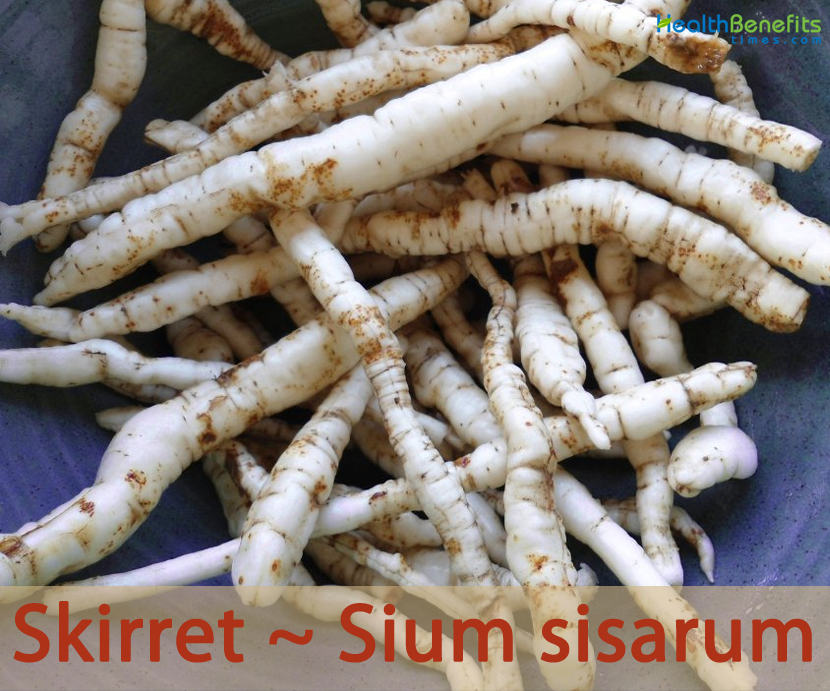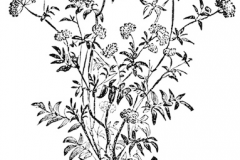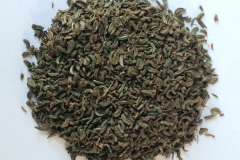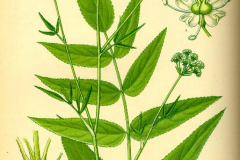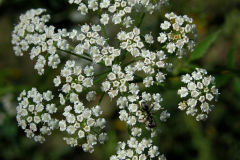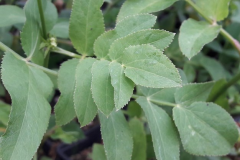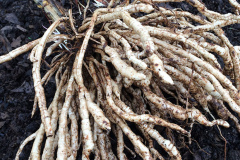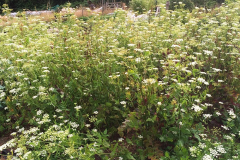| Skirret Quick Facts | |
|---|---|
| Name: | Skirret |
| Scientific Name: | Sium sisarum |
| Origin | China and Japan |
| Shapes | Small fruits are ridged and are composed of two parts that split open at maturity. |
| Taste | Sweet |
| Health benefits | Support Neural Tube Defects, Indigestion, Eye Health, Skin Health, Boosts Energy, Reduces Inflammation, Promotes Urination and Healthy Hair |
| Name | Skirret |
|---|---|
| Scientific Name | Sium sisarum |
| Native | China and Japan |
| Common Names | Skirret, Suikerwortel, Crummock, Zuckewurzel, chervin |
| Name in Other Languages | Afrikaans: Skirret Albanian: Skirret Amharic: Skirret Arabic: Skirret, Sīsārūn (سيسارون ) Armenian: Dahich (դահիճ) Azerbaijani: Skirret, Adi sucuqçətiri Bengali: Skirret Bulgarian: Skirret, tesnolisten rucheĭnik (теснолистен ручейник ) Burmese: Sk rar wate (skရာဝတီ) Catalan: Escaravia Chinese: Cān qín (參芹) Croatian: Skirret Czech: Skirret, Sevlák zeleninový Danish: Skirret, Sukkerrod Dutch: Skirret, Suikerwortel English: Crummock, Skirret, chervin Esperanto: Sciuro, sukerradiko Estonian: Eraldus Filipino: Skirret Finnish: Skirret, Sokerijuuri French: Skirret, Berle à sucre, Berle comestible, Berle cultivée, Berle des bergers, Berle des jardins, Berle des potagers, Chervis, Geyerlé, girole Georgian: Sk’eit’ri (სკეიტრი) German: Skirret, Zucker-Merk, Zuckerwurz, Zuckerwurzel, Berlein, Gartenrapunzel, Gerlein, Gierlein, Girgelen, Gritzel, Klingelmöhre, Klingelrüblein, Süsswurzel, Süßwurzel, Zuckerrübchen Greek: Skirret Gujarati: Skirret Hausa: Skirret Hebrew: Skirret Hindi: Skirret Hungarian: Skirret, keleti békakorsó Icelandic: Skirret Indonesian: Skirret Irish: Skirret Italian: Sium Sisarum, Sisaro, Sedanina coltivata, Japanese: Sukiretto (スキレット), Kurummoku (クルッモク), mukagoninjin (ムカゴニンジン) Javanese: Skirret Kannada: Skireṭ (ಸ್ಕಿರೆಟ್) Kazakh: Skirret (скиррет) Korean: Skirret Lao: Skirret Latin: Siser Latvian: Cīņas Lithuanian: Kovotojas Macedonian: Skiret (скирет) Malagasy: Skirret Malay: Skirret Malayalam: Skirret Maltese: Skirret Marathi: Skart (स्कर्ट) Mongolian: Skirret Nepali: Skiret (स्किरेट) Norwegian: Søtkjeks Oriya: ସ୍କର୍ଟ Pashto: سکریټ Persian: اسکیت, پلم Polish: Spódnica, marek kucmerka, kucmerka Portuguese: Skirret, Sísaro, cherivia Punjabi: Skirret Romanian: Skirret Russian: Skirret, poručejnik sacharnyj (поручейник сацхарный), sladkij koren (сладкий корень), Svekla Primorskaia, porucheynik sakharnyy (поручейник сахарный) Serbian: Skirret (скиррет) Sindhi: اسڪرپٽ Sinhala: Skirret Slovak: Potočník sladký Slovenian: Krilo Spanish: Skirret, Escaravía, Chirivia tudesca, chirivía de azúcar, escaravía tudesca, sisaro Sundanese: Skirret Swedish: Sium sisarum, Sockerrot Tajik: Skirret Tamil: Skirret Telugu: Skirret Thai: Skirret Turkish: Skirret, Su kazayağı, dere kerevizi Ukrainian: Spidnytsya (спідниця), vex sizarovidnij (вех сизаровидний) Urdu: سکرٹ Uzbek: Skirret Vietnamese: Skirret Welsh: Skirret Zulu: Skirret |
| Plant Growth Habit | Small herbaceous perennial plant |
| Soil | Performs well in acidic to neutral soils. Well drained soils are best, as they prevent problems with disease, but skirret grows well even in heavy, swampy soil |
| Plant Size | 3-4 feet and 1-2 foot wide |
| Root | Grayish-white roots grow in clusters from the stem base like sweet potatoes. The roots have a flavor somewhat like potato and parsnip |
| Leaf | Large, shining, dark green, compound, pinnate leaves. |
| Flowering season | During June, July, and August |
| Flower | Flowers are often arranged in a conspicuous umbel (a flat-topped cluster of flowers). Each small individual flower is usually bisexual, with five sepals, five petals, and an enlarged disk at the base of the style. |
| Fruit Shape & Size | Small fruits are ridged and are composed of two parts that split open at maturity. |
| Taste | Sweet taste |
| Plant Parts Used | Root |
| Propagation | By Seed and Division |
| Season | October – March |
| Health Benefits |
|
| Season | October – March |
| Traditional uses |
|
Plant Description
Skirret is a small to medium-sized herbaceous perennial plant that normally grows between 3-4 feet tall and 1-2 foot wide. The plant performs well in acidic to neutral soils. Well drained soils are best, as they prevent problems with disease, but skirret grows well even in heavy, swampy soil. It has a cluster of sweet, bright white roots which are similar to sweet potatoes, but longer 15–20 centimeters (5.9–7.9 in) in length. They have a flavor somewhere between potato and parsnip. When boiled and served with butter, the roots form a dish, declared by Worlidge, in 1682, to be ‘the sweetest, whitest, and most pleasant of roots.’ These are used as a vegetable in the same manner as the common salsify, black salsify and the parsnip.
The plant has large, shining, dark green, compound, pinnate leaves. Small, white flowers are produced in umbels. The flowers are often arranged in a conspicuous umbel (a flat-topped cluster of flowers). Each small individual flower is usually bisexual, with five sepals, five petals, and an enlarged disk at the base of the style. Fertile flowers are followed by small fruits that are ridged and are composed of two parts that split open at maturity.
History
Likely originating in China, Skirret made its way to Europe early in the middle Ages where it was a primary root crop. Unfortunately, Skirret was rather quickly replaced by the potato (from South America) given that potatoes are a larger, more easily cleaned crop. However, Skirret is still used widely through northeastern Asia.
Health benefits of Skirret
Listed below are some of the popular health benefits of Skirret
1. Boosts Antioxidant Production
Skirret is rich source of healthful antioxidants, which the body uses to help combat free radicals, oxidized molecules that are the harbingers of disease. Normal cellular processes can cause free radicals, but their numbers increase because of pollution, smoking, and other detrimental practices. Diet rich in antioxidants helps keep the body healthy.
2. Protection from Neural Tube Defects
Women who are or are trying to get pregnant should be sure to eat a diet rich in foliate. This B vitamin is essential for preventing neural tube defects in developing babies and ensures that the brain and spinal cord form properly. When women suffer from foliate deficiencies, the developing infants are at increased risk for health conditions like spina bifida. Skirret is rich in foliate, making it a good choice for pregnant women or anyone else who wants to get enough of this important nutrient.
3. Soothes Indigestion
Historically, folk medicine practitioners advised people to eat skirret to calm bouts of indigestion. Eating Skirret may ease related conditions like bloating or constipation. Some people find that it helps treat complaints like loss of appetite, too. Adding skirret to spicy stir fry dishes might even prevent heartburn.
4. Support for Eye Health
Vitamin A plays an important role in vision health, and skirret is a good source of this nutrient. The vitamin is important for supporting the outer membrane and surface of the eye and helping guard against viruses and bacteria. Studies show vitamin A can help reduce dry eyes while protecting the cornea. When working together with other nutrients, vitamin A can also reduce vision loss.
5. Boosts Skin Health
As a rich source of vitamin C, skirret offers anti-aging benefits. The skin, in particular, benefits from vitamin C. This nutrient supports collagen production, which ensures skin retains or regains its healthful—and youthful—elasticity. With ample collagen production, the skin looks and feels suppler and is less prone to fine lines and wrinkles. Vitamin C can also help the skin appear more uniform in color and less prone to patches of discoloration, a common occurrence that comes with age.
6. Boosts Energy
Natural sugars contained in skirret can give the body a physical and mental energy boost. Additionally, skirret is rich in B vitamins like niacin and riboflavin. These nutrients help the body convert carbohydrates into energy-giving fuel. The body’s cells require this fuel for their various processes.
7. Reduces Inflammation
Skirret consists of zinc, a nutrient that offers both antioxidant and anti-inflammatory properties. Many diseases stem from increased inflammation, which also causes pain. Individuals with conditions like arthritis can benefit from adding anti-inflammatory foods like skirret to their weekly diet. Zinc can also help reduce the length of time infections like the common cold affect the body.
8. Promotes Urination
Since at least the 16th century, folk medicine practitioners have recommended adding skirret to the diet to promote urination as the primary means to rid the body of toxins. An over-concentration of urine is not good for the bladder or kidneys. Promoting a healthy amount of urination helps eliminate toxins and potentially harmful pathogens from sticking around inside the body too long.
9. Healthy Hair
Skirret is a good source of vitamin E, which nourishes the hair and scalp. Vitamin E has powerful antioxidant properties that reduce the presence of free radicals. By maintaining healthy cells in the hair and scalp, hair appears healthier and is less prone to dryness and breaking. There is some evidence that vitamin E encourages healthy shine and may even help reduce hair loss.
Culinary Uses
- Root can be consumed raw or cooked.
- Roots have a very acceptable taste raw that is somewhat like a cross between carrots and parsnip but with a nutty flavor.
- They can also be boiled, baked or added to soups etc.
- The roasted root has been used as a coffee substitute.
- The roots are scrubbed, cut into lengths, boiled, and served like parsnips or carrots.
- Skirret roots can be stewed, baked, roasted, fried in batter as fritter, or creamed, and also be grated and used raw in salads.
- Woody core may be present in some roots, though this seems to be variable in different plants.
- If present, it should be removed before cooking because it is difficult to remove after.
- It is harvested from the wild for local use as a food.
- This plant was used historically as a flavoring in beers, wines and liquors.
- It can be used interchangeably or with carrots, parsnips, potatoes, or salsify in most recipes.
Other Facts
- There are approximately 550 skirret seeds per gram in well cleaned, fully dry seed.
- The plant grows wonderfully in wild and abundantly found in shaded areas and forest edges.
- The yields will be much better in the second year and will better in the subsequent years.
- The wild ancestor of Skirret grows on the banks of waterways. This shows how tolerant skirret is of moist soils.
- Pliny the Elder stated that Skirret was a favorite vegetable of the Emperor Tiberius.
- Skirret becomes sweeter with frosts like carrots and parsnips.
References:
https://www.itis.gov/servlet/SingleRpt/SingleRpt?search_topic=TSN&search_value=182179#null
https://npgsweb.ars-grin.gov/gringlobal/taxon/taxonomydetail?id=34477
https://pfaf.org/user/plant.aspx?LatinName=Sium+sisarum
https://www.botanical.com/botanical/mgmh/s/skirre51.html
http://www.theplantlist.org/tpl1.1/record/kew-2473919
https://gd.eppo.int/taxon/SIUSI
https://en.wikipedia.org/wiki/Sium_sisarum
https://temperate.theferns.info/plant/Sium+sisarum
https://plants.usda.gov/home/plantProfile?symbol=SISI4


